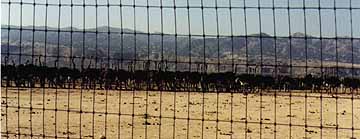
Emu to you?
American Sabbatical 047: 11/6/96
Death Valley
11/6.. Walker’s Pass.
Southern California is very seductive. After all the shivering and shaking, here we were back in June.
David said the days we spent in Santa Barbara were twos (too much
hazy fog), but I’d say tens. A light jacket in the early morn,
shirtsleeves by noon, and the sea air scented with flowers and
eucalyptus. Simply sitting on a wall in the sun is a celebration.
Your body just keeps humming.
And the walls are worth celebrating, too. The Mexican masons in
Santa Barbara do masterful work: stuccoed, unstuccoed, and combinations
thereof. All in warm shades from ruddy orange to the palest yellow
sandstone. I hadn’t thought of Spanish architecture being Masonic.
More in the mud genre.
We did see adobe work. One old mission in particular, which had
weathered into a glowing orange slump of curvilinearity, with
the bell arched into a stepsided facade. Inside, the cool oakframed
apse was arched over with whitewashed plaster, from which radiant
images of the saints shone out. All very solemngaudy, with intense
eyes and encrusted symbolism.
But which way to turn OUR eyes next? We set off into the foothills,
hugging the lesser slopes headed south. We quickly entered the
margin of development where new haciendas are blooming among the
ranchettes and avocado groves. Wherever you go the locals bemoan
the exurban sprawl, unless they are builders and realtors. So
this is the moaning ground of Santa Barbara. But the scars scab-over
with greenery so quick here that yesterday’s slash-and-burn is
tomorrow’s landscaped effusion. Only a rural memory is wounded,
and it’s still paradise to the newcomer.
Our road wound through pocket orchards, between Masonic delights,
and under overarching vegetation, perfumed with blossoms. And
this is November? We decided to climb over the hills to clear
our heads.
Down here the coastal mountains, the Santa Inez backed by the
Sierra Madre, are clothed in impenetrable thickets of scrub chaparral.
Trying to force a horse through these steep and broken upheavings,
clogged with manzanita and other miseries, must have been an exhausting
experience. Little wonder the history of the coast and the valley
were so divergent. Although we encountered tracts of plantings
hacked out of the dry entanglements, most of the rainshadowed
hills have been left to dessicate on their own. Small wonder they
have a California Department of Forestry and Fire Control.
The inland road twists and twizzles enough through the orangeyellow
heights to satisfy any motorcyclist, and tops out a mile high,
with 7500 foot peaks around, then tips over toward the great valley.
We were interested to see this truck garden for America, the land
that feeds us all, so we laughed as we came to the sign “Grocer’s
Grade” and swooped down a long, fast pitch. And there below us
was... a dense sallow smutch. Coming out of clear dry mountain
air we had expected moist green luxuriance. Eden, perhaps. Instead
we descended into the valley of agribiz.
But not before we were graced with another encounter. Rolling
down Route 166 south of Maricopa a big cat suddenly sauntered
into the road 100 yards ahead. A tawny sinuosity with luminous
eyes. Mountain lion. It paused as I pumped the brakes, then turned
and loped back into the chaparral. Invisible in an instant, leaving
us breathless with a fleeting memory and a joy for the wildness.
Below us we noticed a sheep ranch, and smiled at each other carnivorously.

Emu to you?
Then we spilled out onto the flats and ran between the pistachio plantations and the ostrich farms. Dry dusty country intermittently relieved by irrigated pasturage with the hay now made and piled high. Tractors at work in the fields looked to be churning khaki powder, but they must have been stirring rodents as well because they were followed by the big California ravens, and raptors more exalted. A golden eagle pounced down alongside the road just to make our mousehearts jump.
I had anticipated lush swaths of green, and there no doubt are
such places in the valley, farther north and in another season,
but our next encounter on the way to Bakersfield was a petroleum
plantation, barren wastelands nodding with oil pumps and scented
with raw hydocarbons. A garden of sorts, to feed our beasts of
burden.
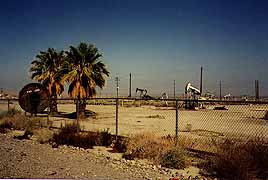
Pastures of Plenty
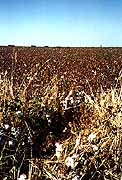
Cotton
Eventually we came onto the old lakebottom where lines of power
pylons diminish into a heatshimmered horizon, and the agribiz
is utterly unrelieved. Miles of plantings we hadn’t a clue about,
dusty dwarf nut trees, and untold acres of cotton. I’d thought
of cotton plants as puffy shrubs you might embrace like a friendly
pillow. The reality is dry twiggy expanses with scattered tufts
of white, looking for all the world like dead weeds with road
litter tangled in them. The effect was heightened by the actual
litter caught up among the plants, and the loose cotton in windrows
on the road.
This garden basket is not a happy place, O consumers of America.
It is a miracle of irrigation in the desert, to be sure, the vast
central valley of California turned into a food factory, but the
land is not lush and fruitful without water and chemicals, and
the faces are worn and hard. This is where all the oversized Californians
have come. Or stayed. The valley must export her slender children
like vegetables, and wouldn’t you, with Santa Barbara over the
hills? Bakersfield gets our prize for the ugliest city in the
US. A wonderland of junked and abandoned hopes and machinery spread
out on a sweltering flat and dusted with agricultural chemicals.
What joy.
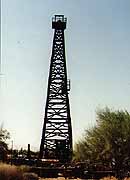
Old Oil
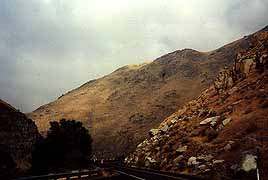
Sierra Highway
Our joy was to keep moving, and like New England weather, California
scenery changes every minute. After a quick scamper to the east
our trail dove into the gap of the Kern River where it tumbles
out of the high sierras, and the landscape was dramatically transformed.
It is astonishing what variety there is among mountain forms.
The Sierra Nevada is utterly unlike the Sierra Madre. In the onset,
the soaring heights rose more precipitous from our squiggle along
the foaming river, and the rock outcrops were huge white granites
or basalts which looked blasted by some cataclysmic explosion.
Beneath the naked crests and among the shining rock fields, bronze
grasses glowed in the clear quivering air. Wholly new species
of pine were dotted around the lower slopes, with sparse sprays
of long fine needles and football-sized cones, bristled with wicked
barbed seeds (Coulter’s Pines). And the highway snaked up and
up. We had stripped down to T-shirts by Bakersfield, but began
to clothe up again as the way climbed.
Now the task was to find a campsite for the night. They were few
and far between on our maps, and those indicated must have been
hiding, because the sun was down behind the heights before we
came upon a county campground unpromised by any of our guides.
We didn’t even think about the implications of its name, Walker’s
Pass. We were simply glad to pull the Owl in under a Joshua Tree
and unfold our tent (still soggy from Bodega Bay). We hiked up
toward the crest through junipers and pines on a dry and crusty
mudrun, dotted with chunks of marble. Then skidded down for chow
and sleep.
PASS, you clowns. A mile high in November means ice in the morning,
and in your toes. Yes, well, this has been an invigorating experience.
11/7... Death Valley.
The stars reach down and poke at you in the mountain passes. Far coyote calls. Yellow sunsplash paints
the eastfacing peaks. Invisible birds twitter and mew in the juniper
and pines. The twisted hairy stems of the Joshua tree, exploding
into yucca spears, take shape in the dawn light. We brew up a
thermos of tea and pack Red Owl with icy fingers, pull our hatbrims
down low, and push off into the rising day.
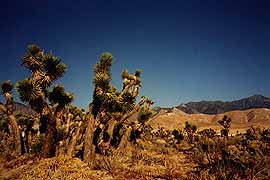
Joshua Trees
Down and down from Walker’s Pass we flew under the morning rise,
the desert around us of equi-spaced sage and creosote bush, with
scattered Joshua trees, all fading to a far whiteness which hides
the enclosing mountains to their knees. Not a cloud in the sky.
Time to dry our bones.
Our highway runs between sections of the Naval Weapons Center,
and the dry lake beds around us have mobile radar tracking dishes
spinning in them. The bleakness intensifies. Inyokern then Ridgecrest.
An anomaly in high desert. A brandnew booming town full of young
people. Condos, housing developments, mini-malls, all sparkling
fresh with decorator plantings. The Dennys has sprinklers rainbowing
an eighth acre of emerald lawn. Is this our military largess at
work, or a selfpromoted suburban bloom without an urb? It felt
like a retirement community, but all the faces were young adult.
We shrugged and passed on.
Moving out onto the basin flats between the Argus range, its broken
beige and folded strata illuminated by the eastern light, and
the dark and shadowed Slate Range, a penetrating alkali taint
pulled at our eyes and singed our noses. Crusted salts pooled
in the bottoms, and tidemarks of encrusted white lapping at desert
shores. Upended eons of sedimentary rocks stand in jagged umber
erosions pointing skyward.
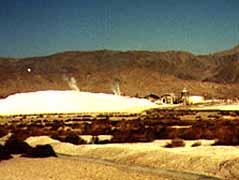
Brilliant Borax
Now we were encountering tractors pulling double dump-trailers of bulk chemicals, and the farseen mill at Trona was spewing stink into the soapy air. The great bare bottom of Searles Lake nudges up against the American Chemical factory, and mountain tipples of crystalline white stand beside rail yards where the gondolas are lined up. Today’s 20-mule team.
And the vegetation gets sparser. Look at a nearby sector and you
see the barest fuzz of fine russet grasses, sparse purple sage
and dustgreen creosote. But raising your eyes to scan the distance,
the landscape is ruddy with the fine growth and clumpy with the
shrubs. The Panamint Mountains now loom up dark to the east, and
the very tops are dusted with snow. Telescope Peak (11,049 ft).
Sentinel (9480). High testimonies of ice, but the valley floor
is shimmering and we are shedding layers.
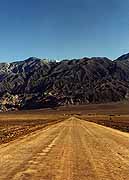
Black Mountains
Then the long climb into the Panamints through a parched tan barrenness with a million glassy dark boulder-fragments spewed across it. From a basin vantage the road disappears into the occluding folds of rumpled mountains. Small wonder early emigrants got turned about trying to find the viable roads over. And some didn’t. Two ranges east the Funeral Mountains tell a tale. But we follow the pavement over Towne Pass, and look down into Death Valley.
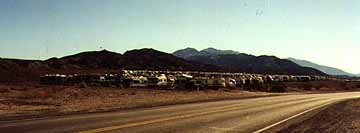
Forty-niners
Hottest, driest, lowest. One of those American Superlative Places. With a wild variety of its own extreme landscapes. And a couplethousand motorhomes jammed into every lot. The 49ers Club Death Valley Days Roundup. The 49ers are a fraternal org. which seems to be a DAR in the far west. Not firstcomers or newcomers, but westcomers. Greeley’s children. All the way across Death Valley there were clots of 49ers grouped around speakers’ platforms or bivouacked in turnouts. But whenever we approached hearing distance, they closed with rounds of applause, and hobbled for the vehicular shade.
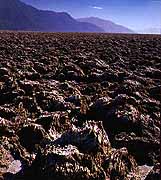
Devil's Golf Course
(Willard Clay Photo)
No cooling euphemisms here. Ash Meadow. Burnt Wash. Furnace Creek.
The closest thing to a comforting metaphor was The Devil’s Cornfield,
a zillion acres where wind erosion has left sage bushes high and
dry on top of their exposed rootballs. The sand has moved into
the adjacent dunescape. Lawrence of Arabia stuff.
We stopped in Stovepipe Wells for breakfast and phonecalls. The
town so named after a spring was located here and marked with
a stovepipe for thirsty followers. Now the place is a tourist
facility run by elderly transients. Our waitress was in her 60s,
comes to the valley for months at a time to feather her retirement,
but dislikes the place because she can’t even get houseplants
to grow. The older serving the elders. Tourism is a geriatric
sport in Death Valley. What did you expect?
Certainly not such diverse desertification. Melted mudrock in
waves like a frozen dunefield. Miles of whitened cinders unrelieved
by a sprig of anything. Umber extrusions among raw sienna outcrops.
Mineral middens of greens and yellows. All the possible combinations
of textures in a cintered spectrum. Sunk in a settling heat. The
roadsigns here warn “DIPS”, not “BUMPS”. This is the lowdownest
down in the US. Down to 282 feet below sea level. And in the middle
of the unsettling hotness there is a dense grove of imported feather
palms, an oasis in the valley of death. The human instinct for
unreality knows no bounds. A tropical parkland, full of aged 49ers.
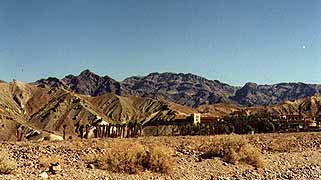
Stovepipe Wells
We take a left turn at a blackened mountain capsizing into the flat basin floor. Then pull down a dusty washboard and stop for a stroll on the bottom. The crunchy cinders are spongy underfoot, and we leave muddy footprints alongside fresh catsign. It must have rained here recently, unlikely as that is with .0-something inches per year. Only this damp crew could find water here.
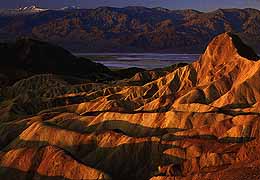
Stealth Eye View
(Larry Ulrich Photo)
And we had one more Darth Valley encounter in store. In our peripheral
vision as we drove back to the pavement something was floating
along the desert floor. Fast. With a phantom jet chasing it. A
black wing out of starwars. Stealth bomber, down below sea level
leaving startled imaginations in its wake. It was gone. Silently.
We climbed out of the lowdown through a whole forest of Joshua
trees, headed for Pahrump and the siren song of Vegas. Our friends
Bob and Frankie left Bowdoinham for Pahrump back in 1989 with
all their belongings in a pickup. They’d run a contracting outfit
on the edge of the highrolling 80s and crashed when the building
bubble burst in Maine. In their glory days Bob and Frankie had
taken a trip to Vegas with a bunch of contractors and bought two
plots in the desert in the paper town of Pahrump, on a lark. Or
maybe a bet. When the boom came down they sold their house, business,
tools, equipment, and doubled-up on square one. We wanted to see
what kind of a flyer they’d taken.
You come out of singed nowhere into a wide parched valley turned
into exploded suburb. Finished and half-finished houses flung
to the four winds, with miles of staked barrenness and sagebrush
between. In this evaporated environ you can leave a houseshell
open to the sky with indifference, and Pahrump looks like the
capital of indifference. Billboards advertising lots of bargains,
and store signs directing you all over the map to vendors in lashups.
How is it that Ridgecrest happens and Pahrump languishes? Or is
it early days yet? Want to buy a lot?
It’s 50 miles from Pahrump Valley to Las Vegas, and after two
years of commuting, Bob and Frankie sold their lots (at a profit)
and moved to where the action is. It only took us an hour. As
you crest the Spring Mountains approaching Los Vegas from the
west you can see Lake Mead, crystalline in the heat-shimmer, beyond
the tops of casino alley. Then the city disappears behind intervening
hills, the lake is just a mirage in memory, and you funnel into
the big suction. Viva, Las Vegas.